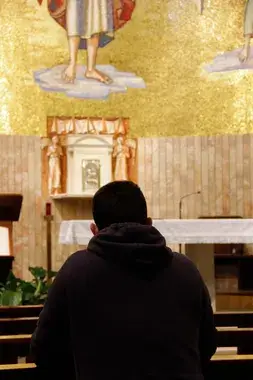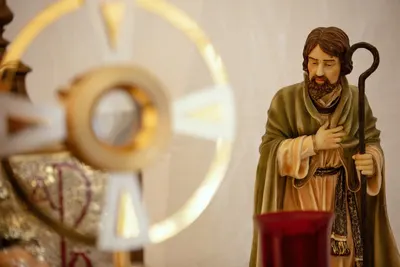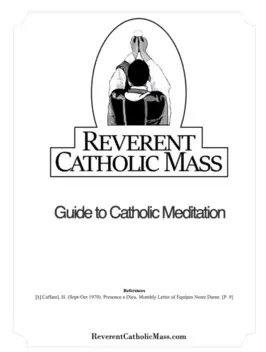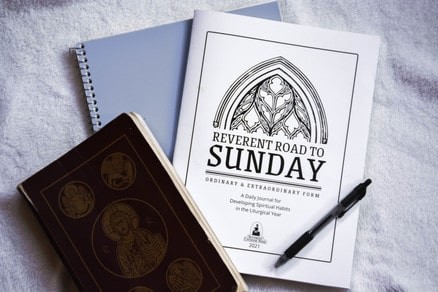
The Essential Beginner's Guide to Catholic Meditation
Are you looking to grow closer to God? This step-by-step beginner's guide will help you to order your prayer and begin Catholic meditation
Before I returned to the Catholic faith, when I would think about meditation, contemplation, mental prayer, and the interior life, I would think in terms of relaxation, disconnecting, and the silencing of the mind.
This is why, at the time, I was attracted to the idea of yoga, mantras, and other practices. I wanted to gain the means to distract my mind long enough to suppress my desires and be at peace.
I later found out that Catholics are much deeper than that.
We know that lasting interior peace can only come from a relationship with God, that we should not disconnect but embrace our crosses, and that our desires, as long as they are properly ordered, are a good.
Catholics meditate and engage in mental prayer to be able have an intimate conversation and relationship with God. But it can be really difficult to know how to do this or even where to begin.
The desire to enter into a relationship with God is written on the hearts of everyone. No one puts this better than St. Augustine. “You have made us for Yourself, O Lord, and our heart is restless until it rests in You.”
To act on this desire is to cooperate with the promptings of the Holy Spirit. It’s a gift.

Bonus: Download a free beginners guide to Catholic Meditation to carry with you! {Printable}
To Know God is to Know Love and to Know Yourself
Catholics understand that God is love, and the embodiment of truth. To know God is to know what love is and to understand truth.
Additionally, the more you know who God is and the better relationship you have with Him, the better you know yourself as you are made in His image and likeness.
Mental prayer is about growing in knowledge and admiration of God and in virtue.
Can’t We do More than Just Pray?
Sometimes we get jaded by prayer and think that, “prayer is nice, but I actually want to do something to help others.” Without a deep prayer life, St. Teresa of Avila would not have been able to reform the entire Carmelite Order. Without a deep prayer life, St. Teresa of Calcutta would not have been able to inspire the world and help the poorest of the poor.
True renewal and constructive outreach can only be achieved if the foundation is built on a solid prayer life.
God pours His grace out upon us when we pray, and grace empowers us to act selflessly in accordance with the Divine will.
Before we can pray and meditate well, be a contemplative, or work on our interior life, we need to know what these things mean.
Related: How to Pray the Rosary Better: 5 Strategies That Really Help
What is the Interior Life?
One of the best definitions of the interior life I’ve read comes from Fr. Reginald Garrigou-LaGrange, O.P. who says,
“From the moment he ceases to converse with his fellow man, man converses interiorly with himself about what preoccupies him most…As soon as a man seriously seeks truth and goodness, this intimate conversation with himself tends to become a conversation with God. Little by little, instead of seeking himself in everything, instead of tending more or less consciously to make himself a center, man tends to seek God in everything, and to substitute for egoism love of God and of souls in Him. This constitutes the interior life.” [1]
Working off this definition of seeking God in everything, one can then begin to use the tools to build up the interior life. These tools are meditation and contemplation.

Bonus: Download a free beginners guide to Catholic Meditation to carry with you! {Printable}
What is Catholic Meditation?
Many use the word meditation interchangeably with contemplation and mental prayer, but in the Catholic sense, it is a distinct form of sustained praying. Meditation is a form of mental prayer and is, “a silent elevation and application of our mind and heart to God in order to offer Him our homages and to promote His glory by our own advancement in virtue.” [2]
There are two forms of meditation: formal and informal. If you practice formal meditation, informal meditation comes naturally.
Formal Meditation is primarily what this post will be about. It is the intentional and methodical act of bringing your mind and your heart to God, so that you can think about Him.
Informal Meditation is the act of thinking about God randomly throughout the day.
Related: How to Pray the Rosary Better: 5 Strategies That Really Help
What is Catholic Contemplation?
Contemplation is considered the higher form of mental prayer and is the act by which the mind admiringly looks upon God in a “Wordless act of love, resulting in a close union with Him” [3]
St. Thomas Aquinas called it the, “simple gaze on truth” and St. Teresa of Avila said, “Contemplative prayer in my opinion is nothing else than a close sharing between friends; it means frequently taking time to be alone with Him who we know loves us.” [4]
Contemplation is not something that people can just do by a sheer act of the will. It is a gift that is given by God through grace. This is why it is considered the higher form of mental prayer.
One can become a contemplative by practicing meditation because by doing so he/she is spending intentional time with God whereby his/her relationship with Him grows stronger.
Therefore, the method of prayer that all Catholics should prioritize is meditation which leads to the gift of contemplation.
Some people will never become a contemplative. I am not a contemplative, at least not yet, and that’s okay as not everyone is given this gift. It does not mean you are a better or worse follower of Christ. It just means you are given other gifts.

Bonus: Download a free beginners guide to Catholic Meditation to carry with you! {Printable}
A Beginner’s Guide to Catholic Meditation.
Checklist Before you Go.
- Confession
- Acquire a good book for spiritual reading
- Locate a church with Eucharistic Adoration
- Schedule at least a full hour so you don’t feel rushed
[ ] Confession:
Before you begin, you must go to confession if you have committed a mortal sin or if it’s been a while. A mortal sin cuts you off from God and thereby also sanctifying grace. You will be unable to attain the graces to pray well and grow closer to God if you are cut off because of mortal sin.
Go to Confession!
[ ] Spiritual Reading:
You need to bring a good spiritual reading book with you. St. Therese Lisieux always prayed using a spiritual reading book and St. Teresa of Avila, “who had advanced fairly far in the ways of prayer…found herself unable to pray without a book, for more than fourteen years” [5]
Below are spiritual reading books we highly recommend:
- The Gospels
- Divine Intimacy: Meditations on the Interior Life for Every Day of the Liturgical Year - Fr. Gabriel of St. Mary Magdalen, O.C.D.
- Anything by Fr. Jacques Philippe
- The Imitation of Christ - Thomas A Kempis (St. Therese Lisieux favorite)
- Manual for Eucharistic Adoration by the Poor Clares
Related: How to Pray the Rosary Better: 5 Strategies That Really Help
[ ] Eucharistic Adoration:
For your first big attempt, you should meditate in front of Our Lord in Adoration. This is always the most ideal place to pray and even more important for your first time.
[ ] Schedule a Full Hour
We recommend that you schedule a full hour for your first time but aim to pray for an uninterrupted 20 minutes. This method will give you a big cushion to pray slowly and methodically in an organized and unrushed manner.
Additionally, you can handle 20 minutes but you won’t be able to really focus if you only have 20 minutes. This is why the full hour allotted allows you to slowly enter the church, slowly kneel, pray, read, go deep, and be intentional.
If you start rushing out the door with the mentality of, “Okay I only have 20 minutes,” you will be checking the time every 3 minutes and will not be successful. Don’t waste your time until you can schedule the full hour.
Finally, sometimes you will schedule the hour intending to pray for a solid 20 minutes and when you are done, you realize that have been praying for 45 minutes and you can’t figure out where the time went.
This is a very good sign that you prayed deeply. It is only possible if you give yourself the extra time be with God.

Bonus: Download a free beginners guide to Catholic Meditation to carry with you! {Printable}
The Steps of Organized Meditation and Silent Prayer
Saint John of the Cross, as described by Kieran Kavanaugh [6], would have initially prayed by dividing prayer into steps, These are the steps that we will follow:
Catholic Guide to Meditation Prayer Steps:
- Preparation & Opening Prayer
- Reading
- Meditation
- Thanksgiving
- Offering
- Petition
Preparation and Opening Prayer: Do Absolutely Everything Slowly
If you follow nothing else from this resource and you really want to pray well, please follow this advice from Fr. Henri Caffarel, the founder of Teams of Our Lady.
“I strongly advise you, therefore, to pay attention to initial gestures and attitudes…Calm and slow movements are of great importance in breaking the rapid and tense rhythm of a busy and hurried life. [7]
The Steps for Preparation: Key Word - Slowly
- Before you walk into the church take a slow…deep…breath…
- Walk slowly into the church and find a seat.
- Slowly lower yourself to both knees, slowly bow down so low that your head almost touches the floor in reverence and respect for God almighty and very slowly make the sign of the cross.
- Slowly make the sign of the cross again as you begin to pray asking the Holy Spirit to help you enter into deep meditative prayer.
- In your mind, slowly speak to God words of praise and ask him to have mercy on you.
Short prayers of praise examples:
- "All glory and praise to You my Lord and my God. You are my everything and you are enough for me."
- "Glory Be to the Father, and to the Son, and to the Holy Spirit, as it was in the beginning, is now and ever shall be, world without end. Amen."
Long prayer of praise example:
- Mary’s Magnificat Luke 1:46-55
Short prayer of mercy example:
- "Have mercy on me my Lord and my God, I have sinned and I am a sinner."
Long prayer of mercy example:
- The Act of Contrition
Related: How to Pray the Rosary Better: 5 Strategies That Really Help

Bonus: Download a free beginners guide to Catholic Meditation to carry with you! {Printable}
The Steps for Spiritual Reading: Same Key Word - Slowly
Do not skip this part as some say that spiritual reading is the essential foundation of meditation.
- Pray, “Speak Lord, your servant is listening.”
- Pick one of the Gospels or a reputable book on Catholic spirituality, and read it slowly and thoughtfully until something strikes you.
- Stop reading
The Way of Catholic Meditation
- Slowly consider and reflect on the part of the reading that has stood out to you.
- Think about it for a while.
- How does this impact your relationship with God? How does it relate to your life right now?
- Talk to God about what you read. Do it slowly.
- Try to remain focused, slow, and precise in your internal conversation, as you will also want to try and “be still” mentally so that little thought is entering your mind. This is when you are more likely to hear that, “still small voice.”
- If you are unable to sustain prayer for at least 10 full minutes, then keep reading until something else strikes you.
- Finally, if the time in prayer was fruitful, write it down.
Give Thanks
We have so much to be thankful for. The more we recognize all that we have been given, the closer we grow to God, who loves us beyond all measure.
- Take some time to thank God for the litany of blessing He has showered on you, for example: this time with Him, family, prosperity, health, etc.
Offering or Resolution
Depending on where your prayer brought you, many times you will be left with a revelation about something you should work on or do. This could be the realization that you should be more generous. Maybe it is the need to forgive a family member.
It is important to take what you have received in this time in meditation and hold onto it.
- Make a resolution to work on whatever it may be that spoke to you.
- Consider writing it down so you don’t forget your resolutions or consolations.
- Offer this resolution to God by praying about it:
“God, I want to serve you and live my life according to your holy will. I offer you this resolution and this time I spent with you in prayer as you know I cannot do or make the changes I need in my life without your help. You know I want to cling to my current way of life. But you said, ‘whomever wishes to save his life will lose it, and whomever loses his life for your sake will find it’ (Matt. 16:25) Show me the path I must walk and help me to stay the course, so that I may remain on this narrow road that leads to you. You are the way, the truth, and the life. I hand this and everything over to you. My life belongs to you. Please make me a great saint.”
Petition
- Simply pray for yourself and your vocation, your family, friends, priests, the Church, poor souls in purgatory, the end to abortion, all those intentions you promised to pray for, anything you can think of.
Conclude
- Ask all these things through the intercession of the Blessed Virgin Mary and pray the Hail Mary and Glory Be.
- Make the sign of the cross slowly
- Slowly exit the church.
Related: How to Pray the Rosary Better: 5 Strategies That Really Help
Common Pitfalls
- Don’t get frustrated. You cannot rush this. Don’t forget to ask God to help you pray better. He will honor that request if you keep asking.
- Don’t seek the “feeling” of being close to God. Feelings are fleeting. Some people think that if they don’t get that “feeling”, then they are not praying right or God is not reaching out to them for some reason. This is not the case. Sometimes you will get consolations and feel close to God, many times you won’t. The point of this kind of prayer is not to get a feeling from God, it is to spend time with Him.
Conclusion
There are countless books on how to pray. This is a very brief primer. If you really want to go deep, then our best recommendation is to seek out books written by the Carmelites. They have preserved and promote the best methods to prayer, and in general, they are very reputable. Additionally, if you have a Carmelite Monastery nearby, seek their counsel or become a 3rd Order Secular Carmelite.
We pray this helps you grow closer to Our Lord and gets you started on your path to a flourishing prayer life.
PAX,
Tony and Kendra
Catholic Meditation Guide to Carry with You!

Grab the Free Meditation Guide!
References:
[1] Garrigou-Lagrange, R., O.P. (1989). The Three Ages of the Interior Life. Rockford, IL: Tan Books and , Inc. [P. 3-4]
[2] Tanquerey, A., & Branderis, H. (1930). The Spiritual Life; A Treatise on Ascetical and Mystical Theology. Rockford, IL: Tan Books and. [P. 320]
[3] Garrigou-Lagrange, R., O.P. (1989). The Three Ages of the Interior Life. Rockford, IL: Tan Books and , Inc. [P. 496]
[4] Catechism of the Catholic Church. (1994). Città del Vaticano: Libreria Ed. Vaticana. [2709, P.650]
[5] Boylan, E. (1963). Difficulties in mental prayer. Westminster, MD: Newman Press. [P. 126]
[6] Kavanaugh, K., O.C.D. (1999). John of the Cross: Doctor of Light and Love. New York: Crossroad Pub. [P. 105]
[7] Caffarel, H. (Sept-Oct 1970). Presence a Dieu. Monthly Letter of Equipes Notre Dame. [P. 9]



